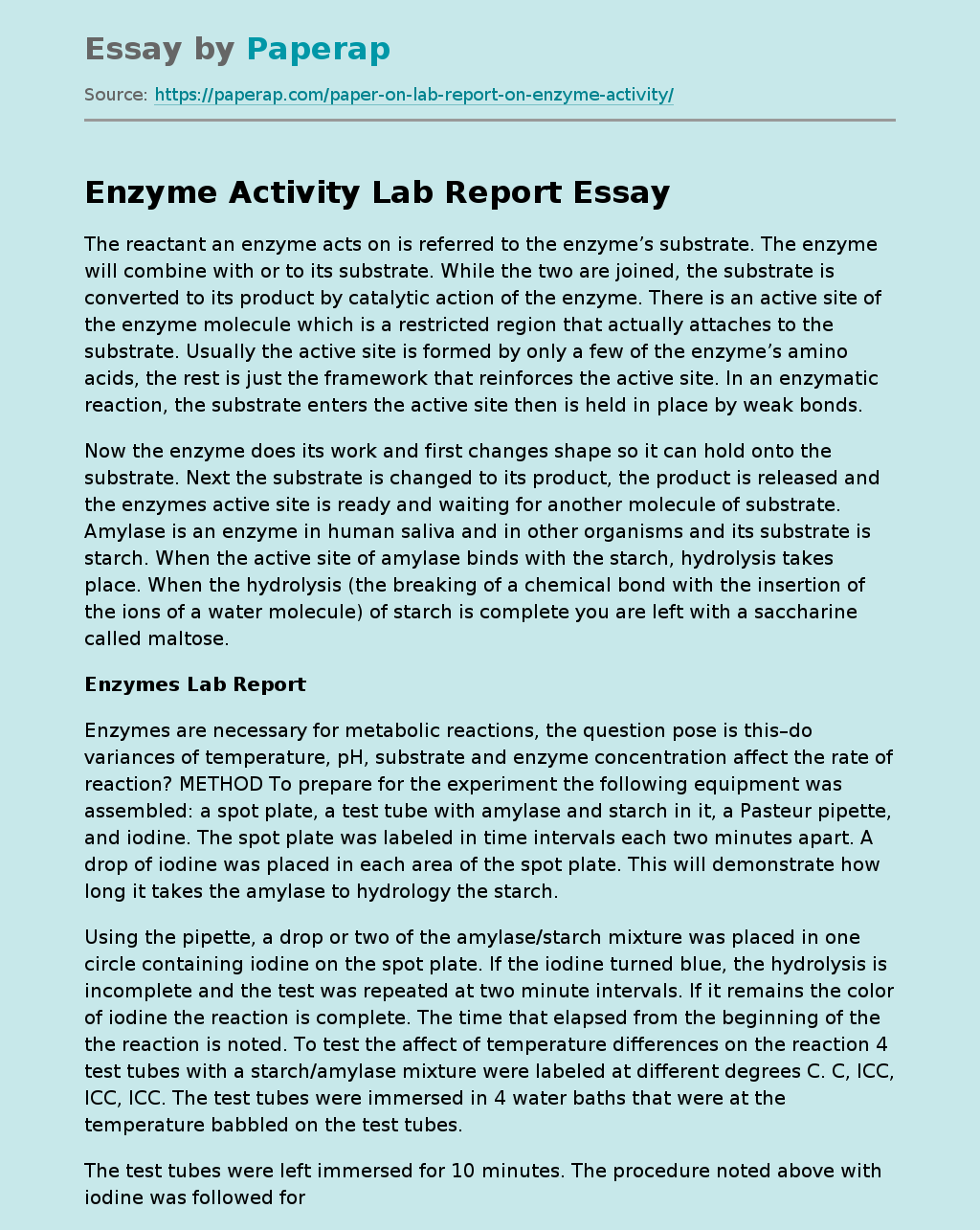The reactant an enzyme acts on is referred to the enzyme’s substrate. The enzyme will combine with or to its substrate. While the two are joined, the substrate is converted to its product by catalytic action of the enzyme. There is an active site of the enzyme molecule which is a restricted region that actually attaches to the substrate. Usually the active site is formed by only a few of the enzyme’s amino acids, the rest is just the framework that reinforces the active site.
In an enzymatic reaction, the substrate enters the active site then is held in place by weak bonds.
Now the enzyme does its work and first changes shape so it can hold onto the substrate. Next the substrate is changed to its product, the product is released and the enzymes active site is ready and waiting for another molecule of substrate. Amylase is an enzyme in human saliva and in other organisms and its substrate is starch.
When the active site of amylase binds with the starch, hydrolysis takes place. When the hydrolysis (the breaking of a chemical bond with the insertion of the ions of a water molecule) of starch is complete you are left with a saccharine called maltose.
Enzymes Lab Report
Enzymes are necessary for metabolic reactions, the question pose is this–do variances of temperature, pH, substrate and enzyme concentration affect the rate of reaction? METHOD To prepare for the experiment the following equipment was assembled: a spot plate, a test tube with amylase and starch in it, a Pasteur pipette, and iodine.
The spot plate was labeled in time intervals each two minutes apart. A drop of iodine was placed in each area of the spot plate. This will demonstrate how long it takes the amylase to hydrology the starch.
Using the pipette, a drop or two of the amylase/starch mixture was placed in one circle containing iodine on the spot plate. If the iodine turned blue, the hydrolysis is incomplete and the test was repeated at two minute intervals. If it remains the color of iodine the reaction is complete. The time that elapsed from the beginning of the the reaction is noted. To test the affect of temperature differences on the reaction 4 test tubes with a starch/amylase mixture were labeled at different degrees C. C, ICC, ICC, ICC. The test tubes were immersed in 4 water baths that were at the temperature babbled on the test tubes.
The test tubes were left immersed for 10 minutes. The procedure noted above with iodine was followed for each test tube and the results documented. To test the effect of pH on the rate of hydrolysis 4 buffered solutions of pH 1. 0, 3. 0,7. 0 and 10. 0 were prepared . 4 test tubes were labeled with the different pH levels. The appropriate buffer solution was added to each test tube. Next . 5 ml of amylase was added to each test tube. The test tubes were plugged and inverted to mix the contents. Beginning with the test tube with lowest pH, 10 ml of starch as added to each tube.
The tubes were again plugged and inverted to mix the contents. Again the procedure with the iodine was followed and the results documented. To test the effect substrate has on the rate of hydrolysis 4 test tubes were labeled with the following substrate dilutions: 50%, 25%, 10% and 5%. In the 4 test tubes, the following starch solutions were prepared: Dilution Starch Water Ion-II Ion-II ml ml ml ml 5% Mil ml . 1 ml of amylase was added to each test tube and the procedure with the iodine was followed and the results documented.
To test the effect of enzyme concentration on hydrolysis, 4 test tubes were labeled with the following enzyme dilutions: 5%, 2. 5%, 1%, . 5%. In the 4 test tubes, the following enzyme solutions were prepared: Dilution Amylase Water 5% 2. Mm’ 0. Ml 2. 5% I. Mol I. Mol 1% . Ml 1. Ml . Mi 1. Ml Then ml of starch to each tube, the procedure with the iodine was followed and the results documented. RESULTS Upon the conclusion of the test, it was determined that variances of temperature, pH, substrate and enzyme concentration did affect the rate of he reaction.
Different than what a person may think, the rate of reaction was longer with the colder temperature and the highest temperature. The rate if reaction shortened with the middle temperatures of 24 and 40 degrees C. In the test of the pH variances, again the results showed the longest rate of reaction in the highest and lowest pH levels. The rate of reaction decreased when the pH level changed from 3. 0 to 7. 0. The substrate concentration variances showed a steady increase in the rate of reaction in relation to increase of concentration.
The enzyme concentration showed a steady decrease in the rate of reaction in relation to increased concentration. All raw data is stated in graphs at the end of this report. CONCLUSION It was confirmed in this experiment that changes in the environment like temperature, pH levels, substrate and enzyme concentrations did effect the rate of reaction. It really should be evident that the substrate and enzyme concentration levels would effect the rate of reaction the was they did as it was noted in the intro of the paper the role each one of these plays in the reaction process.
Enzyme Activity Lab Report. (2019, Dec 05). Retrieved from https://paperap.com/paper-on-lab-report-on-enzyme-activity/

